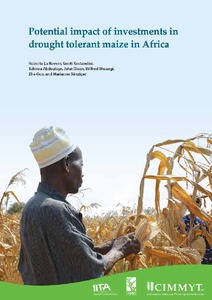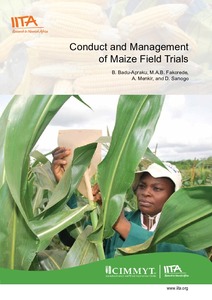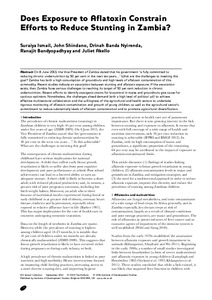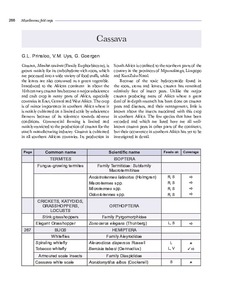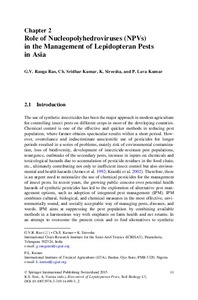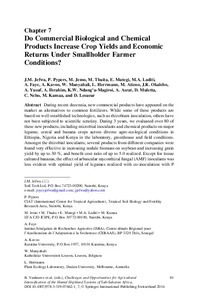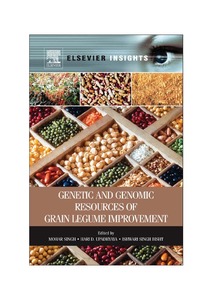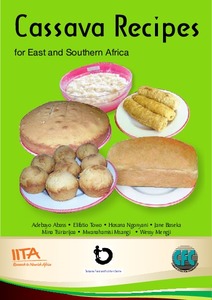Welcome to the International Institute of Tropical Agriculture Research Repository
Books and Book Chapters: Recent submissions
Now showing items 841-860 of 977
-
The control of yam tuber dormancy: a framework for manipulation
(International Institute of Tropical Agriculture, 2011) -
Potential impact of investments in drought tolerant maize in Africa
(International Maize and Wheat Improvement Center, 2010)The study evaluates the potential impacts of the Drought Tolerant Maize for Africa (DTMA) project run by CIMMYT and the International Institute for Tropical Agriculture (IITA) in 13 countries of eastern, southern and West Africa: Angola, Benin, Ethiopia, Kenya, Malawi, Mali, Mozambique, Nigeria, Tanzania, Uganda, Zambia, and Zimbabwe and Ghana. It describes cumulative economic and poverty-reduction benefits to farmers and consumers in those countries over 2007-16, from higher yields and from ... -
Selected morphological and agronomic descriptors for the characterization of cassava
(International Institute of Tropical Agriculture, 2010) -
Exploring climatic resilience through genetic improvement for food and income crops
(Elsevier, 2017-04-10)Plant breeding has been one of the main drivers of crop yield gains during the past century. Breeding for yield improvement through resistance to pests and diseases and chemico-physical constraints to crop production has contributed immensely to food security, nutrition, and improved incomes across Africa. Achievements through breeding have not been evenly spread across the entire range of crops grown in southern Africa. In addition, in some locations climate change threatens to reverse some of ... -
Weed control in cassava cropping systems
(Burleigh Dodds Science Publishing, 2017) -
Implementing guide for planting, replanting and tree diversification in cocoa systems
(Forest & Landscape Denmark, 2010) -
Conduct and management of maize field trials
(International Institute of Tropical Agriculture, 2012) -
IITA R4D Review
(International Institute of Tropical Agriculture, 2012-09) -
IITA R4D Review
(International Institute of Tropical Agriculture, 2012-03) -
Generation and analysis of expressed sequence tags (ESTs) for marker development in yam (Dioscorea alata L.)
(Springer, 2011-02)Background: Anthracnose (Colletotrichum gloeosporioides) is a major limiting factor in the production of yam (Dioscorea spp.) worldwide. Availability of high quality sequence information is necessary for designing molecular markers associated with resistance. However, very limited sequence information pertaining to yam is available at public genome databases. Therefore, this collaborative project was developed for genetic improvement and germplasm characterization of yams using molecular markers. ... -
Clarifying the identity of Amblyseius swirskii and Amblyseius rykei (Acari: phytoseiidae): are they two distinct species or two populations of one species?
(Springer, 2011-04)The generalist predator Amblyseius swirskii is an efficient natural enemy of small insects and phytophagous mites, particularly thrips and spider mites. This phytoseiid species was considered for a long time as a subtropical species and Amblyseius rykei as a sub-Saharan African species. A recent revision of phytoseiid species of the subtribe Amblyseiina from sub-Saharan Africa Zannou et al. (Zootaxa 1550:1–47, 2007) determined that the two species are identical and synonymized them. To confirm or ... -
First report of soybean witchesbroom disease caused by Group 16SrII phytoplasma in soybean in Malawi and Mozambique
(2011)Soybean (Glycine max L.) is an important grain legume cultivated on approximately 1.24 million ha in Africa (1). Malawi ranks fourth in area of production in Africa, with 75,000 ha in 2009 (1). Soybean is also gaining importance in Mozambique and several other southern African countries due to diversification programs. During a field survey conducted in March 2010, soybean plants with phyllody and witches'-broom disorders typical of phytoplasma infection were observed in three of five fields surveyed ... -
Assessment of welfare status and income inequalities among cocoa farming households in Ondo State, Nigeria
(Cocoa Research Institute of Nigeria, 2015)The main objective of this study is to assess the welfare status and the income inequalities among cocoa farming households in Ondo State, Nigeria. Primary data collected from sampled cocoa farmers were used for this study. Descriptive statistics were used to explain the socio-economic variables, farm specific characteristics, and indicators of household welfare status. Gini coefficient and index of dissimilarity were used to assess inequalities in the welfare status of the respondents. The result ... -
Does exposure to aflatoxin constrain efforts to reduce stunting in Zambia?
(Institute of Development Studies, 2014-09)On 8 June 2013, the Vice President of Zambia stated that his government ‘is fully committed to reducing chronic undernutrition by 50 per cent in the next ten years…’ What are the challenges to meeting this goal? Zambia has both a high consumption of groundnuts and high levels of aflatoxin contamination of this commodity. Recent studies indicate an association between stunting and aflatoxin exposure. If the association exists, then Zambia faces serious challenges to reaching its target of 50 per ... -
Cassava
(Entomological Society of Southern Africa, 2014) -
Role of nucleopolyhedroviruses (NPVs) in the management of lepidopteran pests in Asia
(Springer, 2015)Lepidopteran insect pest species cause heavy damage to the crop yield annually around the globe. Baculoviruses, the nucleopolyhedroviruses and the granuloviruses, act as natural regulators of pest populations including lepidopteran pests, and their potential to be employed as insecticides is well reported. Baculovirus-based insecticides are safe to animal and human health and lack toxic residues. In the present chapter, a detailed review on the isolation, characterization, mass production techniques, ... -
Do commercial biological and chemical products increase crop yields and economic returns under smallholder farmer conditions?
(Springer, 2014)During recent decennia, new commercial products have appeared on the market as alternatives to common fertilizers. While some of these products are based on well-established technologies, such as rhizobium inoculation, others have not been subjected to scientific scrutiny. During 3 years, we evaluated over 80 of these new products, including microbial inoculants and chemical products on major legume, cereal and banana crops across diverse agro-ecological conditions in Ethiopia, Nigeria and Kenya ... -
Cowpea
(Springer, 2015)Cowpea, Vigna unguiculata, is an important grain legume adapted to the sub-Saharan Africa (SSA) where it contributes to the nutrition, health, and income of rural and suburban inhabitants. It is indigenous to SSA with both cultivated and wild relatives distributed across the whole subregion. The International Institute of Tropical Agriculture (IITA) holds a collection of more than 15,000 accessions from 90 countries. This valuable source of traits is being exploited to address preferences of ... -
Pathways for sustainable intensification and diversification of cocoa agroforestry landscapes in Cameroon
(World Agroforestry Centre, 2015) -
Cassava recipes for east and southern Africa
(International Institute of Tropical Agriculture, 2013)


